Effective risk management is integral to the success of any organization or facility, and security guards play a pivotal role in implementing strategies to mitigate potential threats. In this comprehensive exploration, we delve into the symbiotic relationship between security guards and risk management, emphasizing the crucial role these professionals play in safeguarding people and assets.
1. Understanding the Landscape of Risk
Before developing a risk management strategy, it’s imperative to understand the diverse landscape of potential risks. This involves assessing both internal and external factors that could impact the security of a location or organization. Security guards, with their trained eye for detail, actively contribute to this process by identifying vulnerabilities, analyzing patterns, and evaluating potential threats.
2. Proactive Risk Identification
Security guards are on the frontline of risk identification. Through regular patrols, surveillance, and access control, they proactively identify potential security threats before they escalate. This early detection allows organizations to implement preemptive measures, minimizing the impact of risks and enhancing overall security.
3. Customized Risk Assessments
One size does not fit all when it comes to risk management. Security guards are skilled in conducting customized risk assessments tailored to the specific needs and vulnerabilities of a particular environment. Whether it’s a commercial facility, residential complex, or event venue, security professionals evaluate unique factors that influence the level and nature of potential risks.
4. Asset Protection
Securing assets is a fundamental aspect of risk management. Security guards are tasked with safeguarding physical assets, intellectual property, and sensitive information. Through vigilant monitoring and access control measures, they prevent unauthorized access and protect valuable resources, contributing directly to an organization’s risk mitigation efforts.
5. Crowd Control and Public Safety
In scenarios where large crowds gather, such as events or public spaces, effective crowd control is crucial for risk management. Security guards are trained to manage crowds, monitor behaviors, and intervene when necessary to maintain order. This proactive approach significantly reduces the risk of incidents, ensuring public safety and minimizing potential threats.
6. Emergency Response Planning
Preparing for emergencies is a cornerstone of risk management. Security guards actively participate in the development and implementation of emergency response plans. Their training in crisis management equips them to respond swiftly and efficiently to various situations, from medical emergencies to security breaches, ensuring the safety of individuals and minimizing the impact of unforeseen events.
7. Surveillance and Technology Integration
Modern security guards leverage advanced surveillance technologies to enhance risk management efforts. Closed-circuit television (CCTV) systems, access control systems, and alarm monitoring are integral tools in their arsenal. By staying abreast of technological advancements, security guards contribute to the overall effectiveness of risk management strategies.
8. Crime Deterrence and Visibility
The mere presence of security guards acts as a deterrent to potential criminals. Their visibility sends a clear message that security measures are in place, discouraging unauthorized activities. This proactive deterrence is a vital component of risk management, preventing incidents before they occur and creating a safer environment for both people and property.
9. Collaboration with Law Enforcement
Security guards often collaborate closely with law enforcement agencies, sharing information and coordinating efforts to address potential risks. This collaborative approach enhances the overall security posture of an organization, fostering a comprehensive network that actively addresses and mitigates potential threats.
10. Continuous Training and Adaptation
The landscape of risk is dynamic, requiring security guards to undergo continuous training and education. This ensures that they remain current with evolving security threats and are equipped to adapt their strategies accordingly. A well-trained security team contributes significantly to an organization’s ability to stay ahead of emerging risks.
11. Threat Intelligence Gathering
Security guards are not only responders but also gatherers of threat intelligence. Through observation, interaction, and collaboration with colleagues, they contribute valuable insights that inform risk assessments. This real-time intelligence is critical for adapting security measures to changing circumstances and emerging threats.
12. Post-Incident Analysis and Improvement
In the aftermath of security incidents, security guards play a crucial role in post-incident analysis. Their firsthand knowledge and experience contribute to understanding the dynamics of the event, identifying areas for improvement, and refining risk management security guards strategies. This iterative process ensures that security measures evolve to address emerging threats effectively.
The collaboration between security guards and risk management is a dynamic and symbiotic relationship. Security professionals are not only the first line of defense but active contributors to the ongoing process of identifying, assessing, and mitigating risks. By understanding the landscape of risk, leveraging technology, collaborating with law enforcement, and participating in continuous training, security guards play a vital role in safeguarding people and assets, ultimately contributing to the overall success and resilience of organizations and communities.




